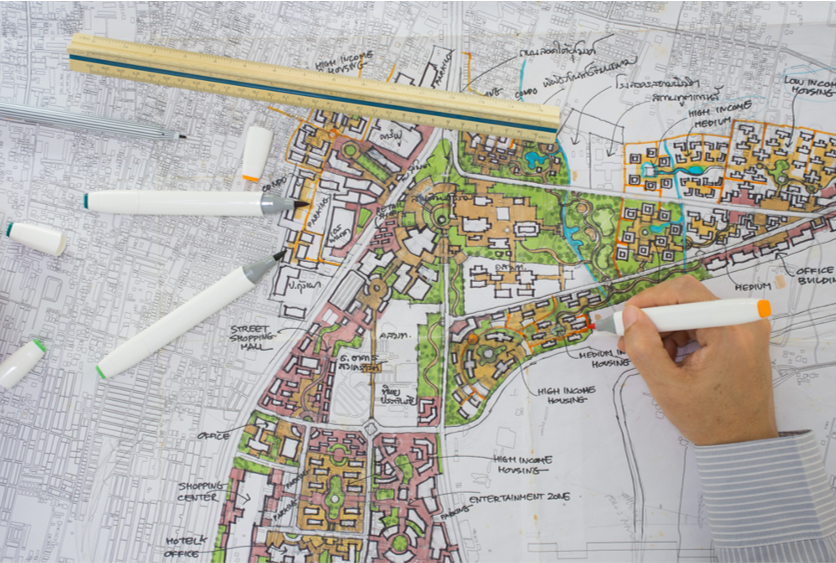What has happened to Joint Strategic Plans?

By Ellen Nicholson
Much has been written on the Government’s proposed new method for measuring housing delivery. Questions have been raised on how targets will be calculated and if they will actually be attainable, particularly in London and the South East.
Currently, the NPPF (2019) states that the presumption in favour of sustainable development applies if the local planning authority demonstrates “substantial under-delivery measured against the housing delivery test” measured against the housing requirement for the previous three years.
In order to deliver a more coordinated approach to development, and in consideration of the NPPF targets, some areas of the UK began developing Joint Spatial Plans (JSP).
Oxfordshire
Back in March 2018, five Authorities in Oxfordshire signed the Oxfordshire Housing and Growth Deal with the Government securing guaranteed funding for affordable housing, infrastructure and economic growth in Oxfordshire. As part of this it was agreed that they adopt a three year pipeline of deliverable housing sites, rather than the five year supply calculations required by the NPPF. A written Ministerial Statement (WMS) to this effect was issued in September 2018 as long as a joint plan delivering 10,000 dwellings was agreed by the authorities. ‘’The JSSP will set the strategic long-term direction for planning and build on the extensive assessment of the infrastructure development required to support growth in housing and the economy expected over the next 25 years.’’ In addition, the Government agreed to provide £150 million for infrastructure to unlock housing sites, to be paid in £30 million instalments over the next five years, plus £60 million for affordable housing and £5 million to boost plan-making capacity.
The JSSP was due to be submitted to the Planning Inspectorate by March 2020. The last round of consultation – ‘Call for Ideas’ closed in April 2019. No further information is currently available.
Despite the lack of progress in a recent appeal decision regarding a 93-unit scheme on greenfield land between Abingdon and Didot, the Council decision to refuse the scheme was based upon inconsistency with their Local plan, being on unallocated land as well as matters regarding lack of infrastructure and affordable housing. The appellant argued that as the JSSP had not been submitted by the March 2020 deadline, the LPA land supply position revert to the five year position required by the NPPF. In dismissing the appeal, the Inspector found the site was not in a suitable location, no longer being allocated and the 2018 Written Material Statement applied and should be read with flexibility.
West of England
In April 2018, the local authorities of Bath and North East Somerset, Bristol City, North Somerset and South Gloucestershire submitted the West of England Joint Spatial Plan to Government. It included policies and principles to determine “the most appropriate and sustainable” locations for development.
Following examination, the Planning Inspector’s letter described the housing supply figure as a “bottom-up summation of existing local plan commitments”, and while there is a 17,000-dwelling requirement for SDLs to provide, “no requirement figures have been considered or identified for any individual settlements, for each local authority area or for any other sub-area of the West of England as a whole”.
In April 2020, the Joint Spatial Plan was formally withdrawn from the examination process. According to the website work is no longer taking place on the JSP and the authorities have instead begun working on a new planning document for the West of England Combined Authority (WECA) Spatial Development Strategy (SDS).
Manchester
Greater Manchester’s Plan for Homes, Jobs and the Environment has been prepared on behalf of the city-region’s ten local authorities. The plan looks ahead over the period of 2020-2037, and identifies the amount of new development that will come forward across the districts, in terms of housing, offices, and industry and warehousing, and the main areas in which this will be focused. It also:
- supports the delivery of key infrastructure, such as transport and utilities;
- protects the important environmental assets across the city region;
- allocates sites for employment and housing outside of the existing urban area; and
- defines a new green belt boundary for Greater Manchester.
A final stage of consultation is expected between December 2020-January 2021 before submission to the Planning Inspectorate.
We will continue to monitor progress of these strategies to see if any actually come to fruition! It will be interesting to see if any other Local Authorities follow this lead in order to set their own housing targets.





